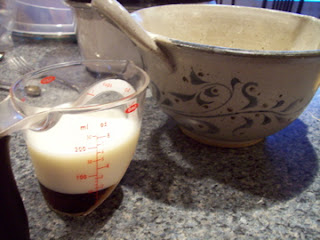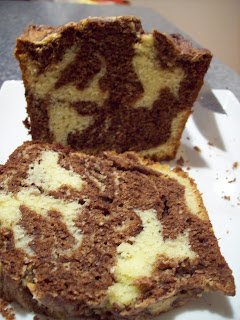I decided to suggest Caramel Pots de Creme because this is a recipe that represents some of the things that are wonderful about Dorie:
- She has encouraged me to try things I've never baked before (and couldn't even pronounce!)
- She has initiated me into the wonderful world of caramel
- Her encouraging advice is just like having a friend standing at my shoulder -- and it is good advice in and out of the kitchen: "The mixture will bubble furiously and may seize -- don't panic, just keep stirring and it will smooth out."
So here are some pictures of my adventure making Caramel Pots de Creme:
 |
| Getting ready |
 |
| Eggs and sugar set aside |
 |
| Melting the sugar |
 |
| Turning to caramel |
 |
| Stand back! |
 |
| It might seize up -- don't panic! |
 |
| The whole set-up into the oven--plastic wrap and all! |
 |
| Cooling. |
I was skeptical of using plastic wrap but used Wegman's Premium Plastic wrap which worked just fine. By using the plastic wrap, I was successfully able to watch what happened when I jiggled the custard cups and avoided overbaking them. They were luscious!
And now for the recipe (really, if you don't own the book, you should order it right this minute):
Dorie says:
Pot de creme, or literally, pot of cream, is the French name for what we Americans have loved for centuries and known for equally long as baked or cup custard. In this recipe, most of the sugar is cooked in a skillet until it caramelizes and turns a deep mahogany color. Once caramelized, sugar is transformed from its well-known sweet self into a liquid that is slightly bitter, here just bitter enough to give a little edge and a lot of interest to the rich custard.
If you've got a pot de creme service (a set of dainty china cups with lids), by all means, use it -- there's nothing more elegant. If you haven't, you can use Pyrex custard cups (the kind sold in most supermarkets), ramekins or espresso cups (actually, espresso cups are my favorites for this recipe).
Don't be alarmed when you see that the custards are cooked in the oven in a roasting pan covered with plastic wrap. This is a chef's trick and it's one that translates easily to the home baker. You needn't worry about the plastic wrap burning -- the oven heat is too low for that. Just be certain to poke air holes in the plastic as directed, and all will be perfect. If you are using pot de creme cups, though, skip the plastic wrap -- the lids are all you need.
2 cups heavy cream
1 cup whole milk
3/4 cup sugar
2 large eggs
5 large egg yolks
Getting Ready: Center a rack in the oven and preheat the oven to 300 degrees F. Line a large roasting pan with a double thickness of paper towels, then put eight 4-ounce (1/2 cup) custard cups, ramekins, espresso or pot de creme cups in the pan. Fill a teakettle with water and put it on to boil; when the water boils, turn off the heat.
Stir the cream and milk together and warm them in a microwave oven or in a saucepan over medium heat; set aside.
Measure out 1/4 cup of the sugar and set it aside.
Put a medium heavy-bottomed saucepan (a nonstick pan works well) over medium-high heat and sprinkle in 2 tablespoons of the remaining sugar. As soon as the sugar melts and starts to caramelize, stir. When the color is uniform, stir in another 2 tablespoons sugar and continue to stir until it is melted and colored. Continue with the remaining 1/4 cup sugar, adding it 2 tablespoons at a time. When all the sugar is deep amber, almost mahogany colored, stand away from the pan, so you don't get splattered, and stir in the warm liquid. The mixture will bubble furiously and may seize -- don't panic, just keep stirring, and it will smooth out. Pull the pan from the heat.
Put the eggs, yolks and reserved 1/4 cup sugar in a large glass measuring cup or a small bowl and whisk until pale and slightly thickened. Still whisking, drizzle in a little of the caramel liquid -- this will temper, or warm, the eggs so they won't curdle. Whisking all the while, slowly pour in the remaining liquid. If there is foam at the top of the custard, skim it off with a spoon (foam isn't fatal, but it will turn into little craters on the top of the baked custards). Pour the custard into the baking cups.
Pour enough hot water from the teakettle into the roasting pan to come halfway up the sides of the cups. Cover the pan snugly with plastic wrap, poke two holes in two opposite corners and very carefully and steadily slide the setup into the oven.
Bake the custards for 35 to 40 minutes, or until the tops darken and custards jiggle a little only in the center when tapped or lightly shaken.
Gingerly remove the roasting pan from the oven and place it on a cooling rack. Allow the custards to rest in their warm bath for 10 minutes, then peel off the plastic wrap and transfer the cups from the water (careful -- they're still hot) to the cooling rack. Refrigerate when they reach room temperature. When the pots de creme are cool, cover them tightly with plastic wrap or their little lids.
Serving: The pots de creme are most elegant served at cool room temperature, but still irresistible chilled. If they've been in the fridge for several hours or overnight, let them sit on the counter for about 20 lminutes before bringing them to the table. These custards need no embellishments -- they're perfect just as they are -- but I find that a swirl of very lightly whipped cream makes a nice finish touch; a light, cool, refreshing counterpoint to the luxurious custard.










